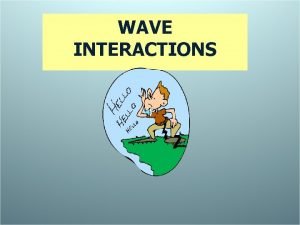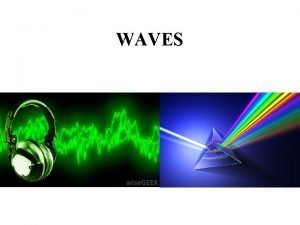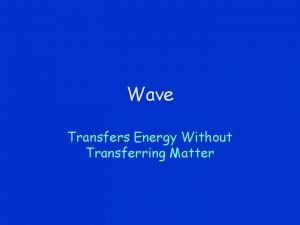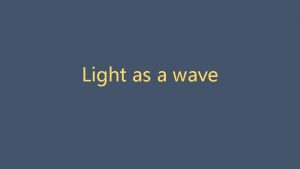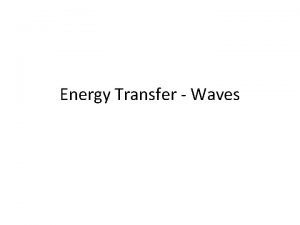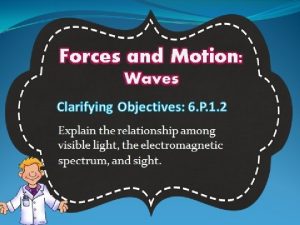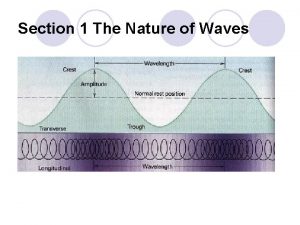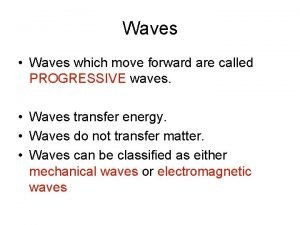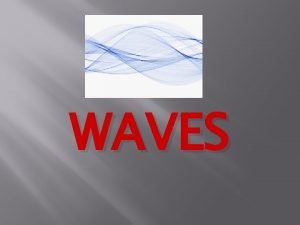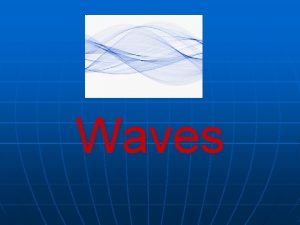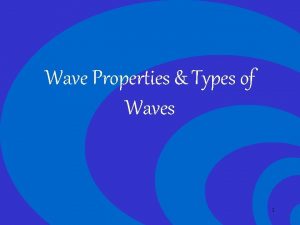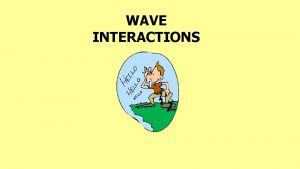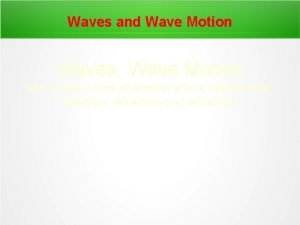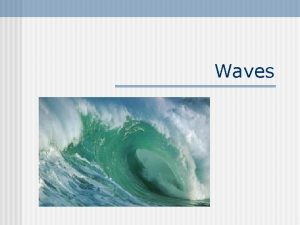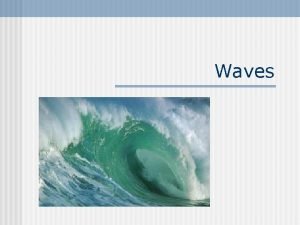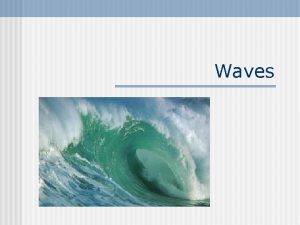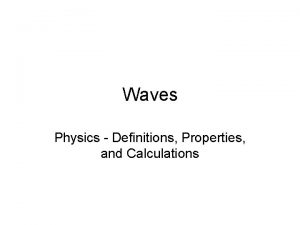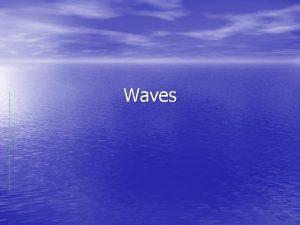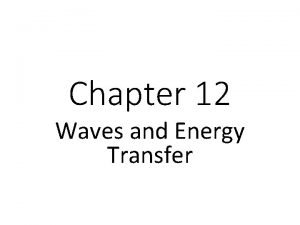Waves Definitions n WAVE a transfer of energy





































- Slides: 37

Waves

Definitions n WAVE - a transfer of energy that does not transfer matter. n MEDIUM –the substance that a wave moves in. n OSCILLATION – to swing or move regularly back and forth. n PROPAGATION – to transmit or move through a medium. • FYI - In a wave, the energy moves through the medium, BUT THE OBJECT STAYS PUT (although it may oscillate).

TYPES OF WAVES MECHANICAL WAVES Need a medium to propagate. (sound, water, etc. ) ELECTROMAGNETIC WAVES Do not need a medium to propagate in.

Electromagnetic Waves n Memory trick: Red Martians invade Venus using x-ray guns.

HOW WAVES PROPAGATE Transverse Waves in which the oscillation of the medium is perpendicular to the propagation of the wave. Longitudinal (or Compression) Waves in which the oscillation of the medium is parallel to the propagation of the wave.


Wave Characteristics Crest & Trough – the high and low points on a transverse wave Wavelength – the length of one complete wave cycle. (e. g. – crest to crest, trough to trough)

HOW WAVES PROPAGATE Wavelength, Compressions & Rarefactions in longitudinal waves correspond to wavelengths, crests & troughs in transverse waves.

Wave Characteristics Amplitude – refers to the distance the medium oscillates from equilibrium. Amplitude indicates the amount of in the wave.



Remember! n A wave doesn’t move the medium…it’s just energy traveling through the medium!

Wave Characteristics Wave Period – the time it take for one complete wave cycle to pass by a given point. Frequency – the number of waves that pass by a given point per second. Frequency & Period are related

!!! WAVE EQUATION !!! V = ƒλ velocity = frequency * wavelength

Some Problems Q 1. A sound wave has a frequency of 3250 Hz and a wavelength of 0· 1 m. What is its velocity? Q 2. A sound wave travels with a velocity of 330 m/s and has a frequency of 500 Hz. What is its wavelength? Q 3. A wave at sea travels with a velocity of 25 m/s. If it has a wavelength of 10 m, what is its frequency?

Wave Behavior

Wave Interference: when two waves get to the same spot at the same time Superposition Principle – The total amplitude caused by two or more waves occupying the same space in a medium is equal to the sum of the amplitudes of each of the individual waves. Constructive Interference – The addition of two or more overlapping waves that produced a wave of increased amplitude.

Wave Interference: when two waves get to the same spot at the same time Destructive Interference – The addition of two or more overlapping waves that produces waves of decreased amplitude.

Reflection The bouncing back of waves as they strike a barrier or encounter the boundary of another medium.

Law of Reflection: Angle of incidence = Angle of Reflection All angles are measured with respect to the normal Normal – dotted line drawn perpendicular to the surface where the light ray hits the reflecting surface

REFRACTION The changing direction of waves as they pass into different mediums. Check this out! (link) When a wave enters a new medium, the change in density of a new medium causes the wave to travel at a different speed. If the new medium is more dense, the wave will slow down. If it is less dense, the wave will speed up.

Refraction

Diffraction The bending of a wave around a barrier, such as an obstacle or opening. Occurs when a wave passes an edge, passes through a narrow gap or goes past an object. None of the properties of a wave are changed by diffraction. The wavelength, frequency, period and speed are same before and after diffraction. The only change is the direction in which the wave is traveling.

Resonance: Natural Frequency n n Nearly all objects, when hit or struck or plucked or somehow disturbed, will vibrate. If you drop a meter stick on the floor, it will begin to vibrate. If you pluck a guitar string, it will begin to vibrate. If you blow over the top of a pop bottle, the air inside will vibrate. When each of these objects vibrates, they tend to vibrate at a particular frequency. The frequency at which an object tends to vibrate with when hit, struck, plucked, strummed or somehow disturbed is known as the natural frequency of the object. Musical instruments vibrate at their natural frequency when a person hits, strikes, strums, plucks or somehow disturbs the object. n

Resonance: When one object vibrating at the same natural frequency of a second object forces that second object to start vibrating.

Sample question: A guitar player is seated next to a piano. The piano player strikes an E key on the piano. The guitarist reports that this causes the E string on his guitar to vibrate. What is the name of this phenomenon? F interference G the Doppler effect H resonance J standing waves

Polarization n n A method of reducing the number of planes that light waves are vibrating in. Polarizing sun glasses reduce glare by blocking light waves vibrating in a certain direction.

Polarization: Polarized light vibrates in only one direction: filters out horizontal waves and leaves only vertical waves

Practice Problems!

Problem 1: Wave types & characteristics Which of the following is not true about a wave? A. Its energy increases as its amplitude increases. B. Its frequency increases as its wavelength decreases. C. Its velocity is equal to its frequency times its wavelength. D. It transfers the particles of the medium along with the energy created by the disturbance.

Problem 2: Wave types & characteristics Which wave has the greatest velocity?

Problem 3: Wave types & characteristics At 0°C sound travels through air at a speed of 330 m/s. If a sound wave is produced with a wavelength of 0. 10 m, what is the wave’s frequency? F 0. 0033 Hz G 33 Hz H 330 Hz J 3300 Hz

Problem 4: Wave Interactions The diagram shows waves approaching a barrier. Which pattern will be formed after the waves pass through the opening in the barrier? Also – what is the name of the wave phenomenon shown?

Problem 5: Wave Interactions Polarized sunglasses are useful because – F. They are dark and don’t allow as much light to come through. G. They reflect much of the light from their surfaces. H. They filter out the horizontal transverse waves in light while allowing only the vertical waves to get to the eyes. J. They both diffract and refract light.

Problem 6: Wave Interactions Dolphins and bats use echolocation to hunt prey. They determine the distance to their prey by sending sound waves out and measuring the time it takes for the sound wave to return. This demonstrates the ability of sound waves to A. Refract B. Interfere C. Reflect D. Polarize

Problem 7: Wave Interactions When trying to spear a fish in water, a person needs to take into account the way light bends as it moves from water into air. The bending of light as it passes from one medium into another is known as — F reflection G refraction H diffraction J polarization

Problem 8: Wave Interactions One tuning fork is struck and placed next to an identical fork. The two forks do not touch. The second tuning fork starts to vibrate because of — F interference G the Doppler effect H resonance J standing waves
 Energy energy transfer and general energy analysis
Energy energy transfer and general energy analysis Energy energy transfer and general energy analysis
Energy energy transfer and general energy analysis Waves transfer energy without transferring
Waves transfer energy without transferring Rate of energy transfer by sinusoidal waves on strings
Rate of energy transfer by sinusoidal waves on strings Repeating disturbance that transfers energy
Repeating disturbance that transfers energy Wave transfers
Wave transfers Example of a mechanical wave
Example of a mechanical wave Do light waves transfer energy
Do light waves transfer energy What transmits energy without transferring matter
What transmits energy without transferring matter Mechanical waves and electromagnetic waves
Mechanical waves and electromagnetic waves Transfer of energy when a wave disappears into a surface
Transfer of energy when a wave disappears into a surface Low amplitude wave
Low amplitude wave Light is electromagnetic wave true or false
Light is electromagnetic wave true or false Characteristics of a longitudinal wave
Characteristics of a longitudinal wave Sound waves longitudinal waves
Sound waves longitudinal waves Long waves and short waves
Long waves and short waves Mechanical waves and electromagnetic waves similarities
Mechanical waves and electromagnetic waves similarities Examples of mechanical and electromagnetic waves
Examples of mechanical and electromagnetic waves Mechanical and electromagnetic waves similarities
Mechanical and electromagnetic waves similarities Seismic waves
Seismic waves Is a seismic wave mechanical or electromagnetic
Is a seismic wave mechanical or electromagnetic Compare and contrast p waves and s waves using venn diagram
Compare and contrast p waves and s waves using venn diagram Mechanical and electromagnetic waves venn diagram
Mechanical and electromagnetic waves venn diagram Difference between constructive and destructive waves
Difference between constructive and destructive waves Ability of two or more waves to combine and form a new wave
Ability of two or more waves to combine and form a new wave Progressive waves travelling disturbances that transfer
Progressive waves travelling disturbances that transfer A wave is a disturbance that transfers
A wave is a disturbance that transfers Difference between full wave and half wave rectifier
Difference between full wave and half wave rectifier Example of longitudinal wave
Example of longitudinal wave Half wave rectifier definition
Half wave rectifier definition Full wave rectifier center tapped transformer
Full wave rectifier center tapped transformer Earthquake p-wave and s-wave travel time graph
Earthquake p-wave and s-wave travel time graph Rectified sine wave fourier series
Rectified sine wave fourier series A ____ is a repeating disturbance or movement that
A ____ is a repeating disturbance or movement that The wave chapter 10
The wave chapter 10 Quarter-wave symmetry
Quarter-wave symmetry Velocity frequency wavelength triangle
Velocity frequency wavelength triangle Wave transfer matter
Wave transfer matter


